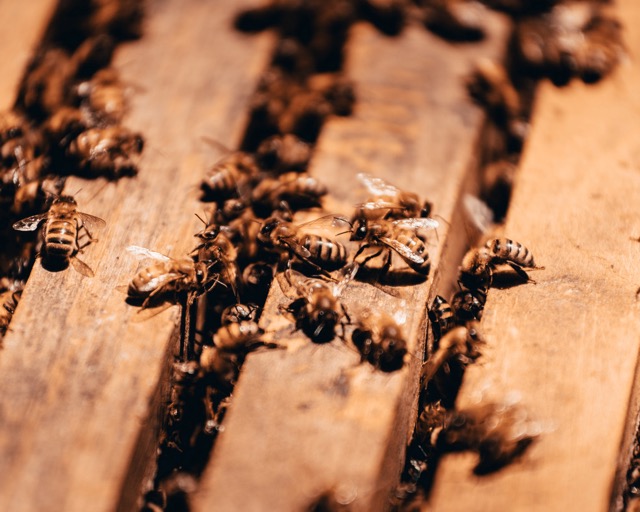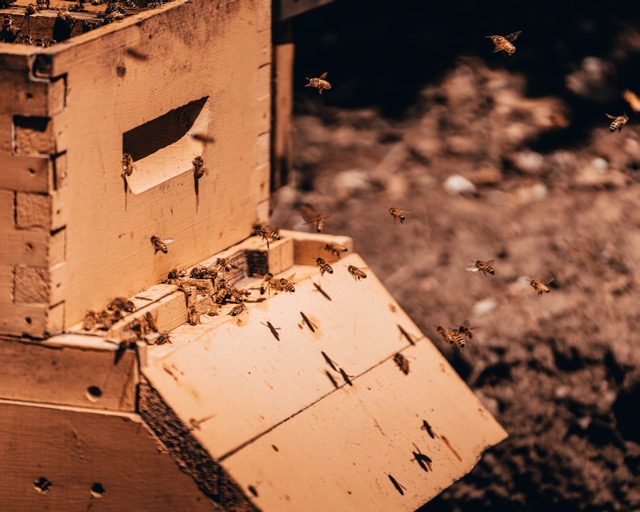$175 and two days later they left. The package of bees I bought two years ago. I installed them and they absconded two days later. Who knows why? I should know what I’m doing; I’ve kept bees most years since 2009. Still, they took off. Left their hive cold and empty, $175 in their flown-off wake. I tried to catch a swarm to replace them. I put out an alert to neighbors, looking for free bees, added drops of lemongrass in my empty hive to lure them. Last year too. No luck. Two years without my own girls in my garden, I missed the pulsing life of their hive. This year I handed over my credit card and once again drove home a screened wooden package the size of a shoebox. 10,000 bees. One queen.
An agent wants to see my book proposal. I spent much of fall writing it, and revising three sample chapters. I should know what I’m doing; I’ve been revising for years. In the past few months, though, my notions of revision have blown open. In March, my writing cohort had an online revision retreat with our mentor, Kate. We talked about looking at our drafts to understand the questions burning beneath. I’ve been reading George Saunders’ thoughts on revising drafts to create an expectation in the reader. And my writing teacher Megan read 100 pages of my manuscript and wondered about the “now me”–the mother revisiting 20 years of my kids’ lives. Should that self be more present in my revisions? I’ve spent years tinkering with the lines of these chapters, though tinkering wasn’t what I needed to do. What I really needed to do was figure out the underlying questions, the work’s beating heart.

In a hive the queen is everything. Have you ever seen a swarm in the wild or in photos, how the bees hang in a football-shaped cluster? The queen is almost always at its center. The bees are protecting her, keeping her warm. If they lose her before finding a new home, there will be no eggs, no new worker bees, and bees only live for six weeks. They can raise a new queen, but that takes time. The queen is the hive’s beating heart. When you buy a package–for $175!–you’re buying 10,000 bees and a queen that doesn’t belong to them. Usually, you place her in your hive inside a little cage with a candy plug that the bees chew through, hoping that in the days it takes for the bees to chew through to her, they will adapt to her scent and accept her as theirs. Usually, that’s what you do.
Revising isn’t tinkering with lines. Revise means, literally, to re-see. In Living Revision, a book I’m loving, Elizabeth Jarrett Andrew writes, “The primary task of a rough draft is to discover what the story might be and why the writer might care.” You are not writing lines to tinker with–you are writing simply to see what you have to say. Your first job is to make a start, something you can put aside, come back to later. Only then can you see what you have and begin to shape it.

When you install a new colony, their first job is to draw comb. If there is no wax, the queen has no place to lay eggs. Most beekeepers place a sheet of wax or plastic foundation in the frames to help the bees know where to build. I’ve never done this. I’ve always followed the wisdom of “natural beekeepers” like Michael Bush and Hilary Kearney–my main reason for going foundationless being that the bees seem to prefer it. Yes, sometimes they build their comb in ways that make it harder for me to get into the hive, but I’ve always been able to fix that. I want to leave as much as possible to the bees and their intuitive ways.
The trouble with tinkering with drafts is that you shut them down. I’m often fixing sentences, replacing words, polishing lines to make them sound pretty before I’ve stepped back to see if I’ve built the right foundation in the first place. I need to figure out the emotional core, the beating heart of what I’m writing first. Once I know what I’m trying to explore, I can move things around, start somewhere different, maybe write in a different form–turn a traditional essay into an essay written, say, in the form of a Q & A. When I start prettifying sentences too soon, I stop seeing possibilities. Better to keep things open longer, give my intuition time to make connections and leaps. Give myself time to trust my process.

The trouble with tinkering with beehives is it stresses out the bees. When you open the hive, you change the temperature the bees have worked hard to maintain for the queen, for rearing brood and storing honey. You interrupt their busy work as you pull out frames, searching to make sure all is well, that you have eggs and a queen. With a new colony, you it’s good to get in there every few weeks or so, but best to mostly observe from outside the hive. Watch them emerge the first day, make their orientation flights. Watch them begin to forage, return with pollen on their legs. You need to trust that all is well inside. You need to trust the process.
I’m finding new ways to write. Inspired by Lynda Barry, I’m trying to draft with my hands. When Jenny Offill wrote a novel that didn’t work, she took the advice of a writer friend–a poet, I think–and started copying the best bits on index cards. Those index cards got fleshed out, moved around, added to and became Dept of Speculation, which you know I love. Offill wrote Weather the same way: the image of her in-progress fragments in her New York times interview makes my heart flutter. (I was supposed to work with Offill for a week last summer; when the workshop got canceled, that same heart cracked.) I’m revising the three sample chapters for my proposal, the ones I was so sure were ready. I’ve printed out my polished drafts. I’ve highlighted the best bits, written them on index cards. I’m moving things around, writing whole new sections, tossing out other parts altogether. Gulp.

I’m not sure why my bees absconded two years ago. Michael Bush warns that new colonies may not like screened bottom boards–which I’ve always used–as they may make the hive seem too airy, too exposed. I took his advice and temporarily sealed the space with cardboard. He also warns against the common advice to leave the queen in her cage, banded to a frame. Not a good idea for foundationless beekeepers, he says–the bees will almost always begin building comb beneath that cage, starting everything off wonky. Just leave the candy plug out, he says, let the queen emerge on her own. Trust that the colony will accept her; he’s rarely seen colonies kill a new queen. I’ve never done this before but I went with it. I let her loose and closed the hive. Gulp.

Four days after installing the hive, I zip myself into my bee suit. I’ve been working on the manuscript chapter set in 2003, an essay in list form about the homeschooling projects the kids’ initiated on their own. I lift the hive’s copper roof, take off the syrup feeder, the inner cover. The kids were so busy that year, H teaching himself magic tricks, making LEGO Harry Potter movies; L cooking and sewing and reading on her own; T learning to walk, to talk, to run. The bees have been busy too–four days and already two frames are half-full of tender white comb, four others one-third there. Megan wrote on this chapter draft: YOU CHOSE THESE MOMENTS. For each one: why? What did each one show you, then and/or now? I write each moment on a blank white index card, then look back through my journals, try to see emotional core of my questions, let my intuition guide their order. I’m looking through the frames one by one, trying to find the queen, hoping she’s still there. H is home from New York for a film shoot; he follows me out to the hive to take photos, like he did with my first hive, a dozen years ago. I’m delighted with the comb, the calm bees, the way my mess of a draft is coming together. It isn’t until I pull out the last frame that I spot her. The queen, circling the frame, dropping eggs into wax cells. Insuring the colony will continue. I ease the cover back on the hive, trust that all is well, hang my suit, and get back to my draft.

* * *
more inspiration from april:
—These amazing portraits from artist Kumi Yamashita, truly stunning versions of the nails & string art you did in junior high math class.
–Hilary Kearney, mentioned above, a young natural beekeeper from San Diego with a cool instagram account chronicling her work. I love her book Queenspotting, full of fascinating bee info and really great photos of frames covered in bees that give you practice searching for the queen, Where’s-Waldo-style.
—T Kira Madden’s classes. I inhaled her fragmented memoir Long Live the Tribe of Fatherless Girls and took a class with her at Grub Street’s Muse and the Marketplace Conference a few weeks back. (Usually in Boston, but this year, virtual. So fantastic–workshops with Jenny Offill! Melissa Febos! Paul Lisicky!– that I’ll consider going in person if I can swing it.) T Kira’s class, Pathways of the Mind–finding mini-moments of surprise and transcendence in your writing–was so good that I immediately signed up for a class she was offering the next day at Corporeal Writing. She shares incredibly fruitful methods of list-making during early drafting, and finding ways to connect objects and ideas that you might not think to place together. (Did I use her methods to write this blog post? I did!) Keep an eye out for her classes–she has one coming up with Lighthouse Writers Workshop!
Tell me: what has you inspired these days?


I always love how your process includes patience, and now, I see the space for newness that has made. This was so interesting and appealing. You are revising MY understanding of the writing process.
I’m so glad it was interesting, Amy! It amazes me that after all these years I still have so much to learn. “Space for newness” is an awesome phrase. My goal these days! (I fixed your typo. I used to have a widget that let commenters do that–I hate when I can’t fix my typos…)
You. You inspire me.
Back at you, my sweet. Your perseverance through all this hits me deep in the heart.
Emily said it – you inspire me to follow my dreams. Thank you. It is always good to read your thoughts… on anything and everything.
It is such a gift to be lovingly read–thank you, as always, CathyT! Isn’t it funny how sharing our own failings can manage to inspire others? I don’t know exactly how that works, but I know it’s real. <3
Loved this piece for its composure and the way two threads wound more tightly together as we, the reader got wrapped up in both narratives. So very excited to read more! -j
Thank you for taking the time to read, my dear friend! It means a lot to me. xo!
Happy Mother’s Day Tricia!
Who would’ve guessed there’d be parallels between beekeeping and your writing revision process? The ones you shared are unique.
What I’ve observed over the years is your openness to learn all sorts of new things; and to share what you’ve learned lovingly and humbly. It’s that sweetness and curiosity, along with your sensibility and persistence to get it ‘right’ that will take you through your revision steps and get you to the finish line! And I’ll be there at the end primed to read your book.
As for your bees, enjoy them while it lasts. We beekeepers know how precious having them around is.
Kristin, thank you for this thoughtful message. It made me a little teary! It means so much to have a friend who sees the best in me. I appreciate having you alongside me, on your own parallel creative journey. Hope your Mother’s Day was lovely!